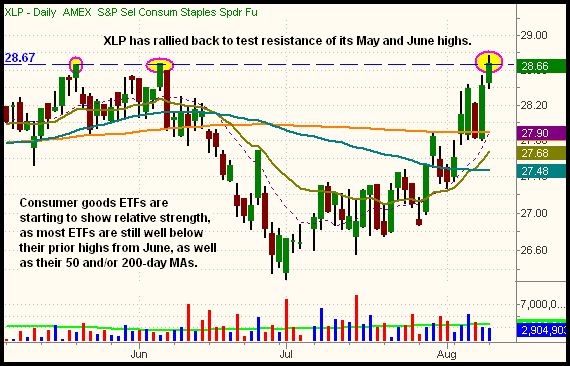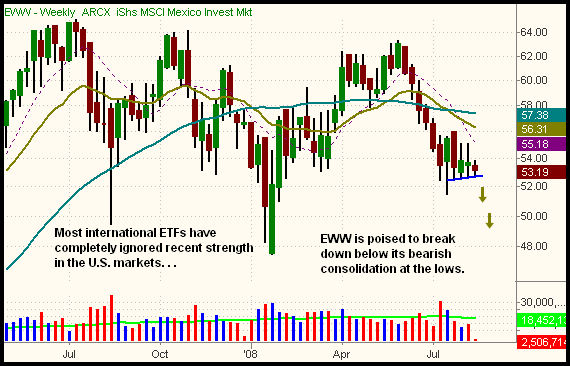|
The Wagner Daily ETF Report For August 12
Bullish momentum from last week's strong close carried through into yesterday's session, lifting stocks higher across the board. The Nasdaq Composite gained 1.1%, the S&P 500 0.7%, and the Dow Jones Industrial Average 0.4%. Stealth relative strength in small-caps carried the Russell 2000 another 2.3% higher, as the S&P Midcap 400 climbed 0.9%. Despite the market's broad-based advance, stocks surrendered nearly half their morning gains in the afternoon. All the major indices closed just above the middle of their intraday ranges.
Total volume in the NYSE rose 7% above the previous day's level, while volume in the Nasdaq increased 5%. The market's higher volume gains technically caused both the S&P 500 and Nasdaq Composite to register a bullish "accumulation day." However, note that most of the volume increase occurred near the intraday highs of the major indices, not as stocks were climbing. When this occurs, followed by weakness into the close, it is known as "churning," which is caused by institutional selling into strength. Considering the major indices are still in long-term downtrends, it was not surprising that mutual funds, hedge funds, and other "smart money" players would sell into the strength of yesterday's gains. A single session of selling is also not cause for panic. Nevertheless, don't interpret too much bullish sentiment from the fact that higher volume accompanied yesterday's gains. In this situation, the higher volume gains were actually a slightly negative factor. In the NYSE, advancing volume exceeded declining volume by a margin of less than 2 to 1. The Nasdaq adv/dec volume ratio was positive by 7 to 2.
Joining the list of industries with relative strength is the consumer goods sector, specifically the non-discretionary retail sub-sector. To illustrate this, take a look at the daily chart of S&P Consumer Staples (XLP):

Not only is XLP above its 20, 50, and 200-day moving averages, but it's also already testing resistance of its May and June 2008 highs (marked by the dashed horizontal line). Although volume has not been impressive, we don't necessarily expect turnover to surge higher until XLP convincingly breaks out above its prior "swing highs" from May and June.
Presently, only a handful of ETFs have recovered all the way back to, or above, their June highs. Not surprisingly, most are ETFs in the healthcare sector, and are trading at new highs. Tickers in the healthcare arena we've been analyzing and trading include: BBH, IBB, XBI, IHI, and IYH. The consumer goods sector may be shaping up for a second place lead within the broad market. We're also keeping an eye on software, which is starting to show signs of accumulation.
Curiously, we've noticed that nearly every international ETF has ignored the domestic stock market rally of the past week. As the main stock market indexes have been breaking out to new "swing highs," most of the international ETFs, from Asia to Europe to Africa to Central America, have been consolidating at or setting new lows. iShares Latin America (ILF), for example, was a former market leader within the international arena. But yesterday, as the domestic stock market built on its new intermediate-term uptrend, ILF tumbled 3.1%, closing at its lowest level of the past six months! Also showing major relative weakness to the U.S. is iShares Mexico (EWW), which has been consolidating at its recent lows for several weeks. A breakdown below the low of the past three weeks would actually create an ideal short sale opportunity. Take a look at the weekly chart of EWW:

The horizontal line on the chart above marks the low of the past three weeks. A sell-off below that level would constitute a legitimate short sale entry, but be aware of minor support from the low of the week ending July 18. Are there any international ETFs bucking the trend? The only exception we noticed was iPath India Index (INP), which has actually been moving in a very similar pattern to the S&P 500. Still, it is never advisable to buy the only strong ETF in a sector that is mostly weak. Doing so is akin to swimming upstream in a strong current; it's possible you'll make it, but it's much more likely you'll get washed down the river.
Based on the market's recent momentum, our near-term bias is bullish, intermediate-term bias is neutral, and long-term bias is bearish. Realize these biases are based on the trends of the main stock market indexes at various time intervals, not my subjective opinion. Over the past several days, we've sold a few ETFs into strength to reduce our long exposure, so we now have just two open positions, both of which are on the long side. "Wait a minute," you cry, "the major indices just broke out to new swing highs and above their 50-day MAs!" That is indeed true. However, we've learned over the years that counter-trend bounces within bear markets (such as the present one) frequently reverse when the charts are presenting the most obvious buy points (such as the rally above the July 23 "swing highs). Just when people start to get confident on the long side again, that's when the dominant downtrend usually resumes.
Since we're still technically in a primary bear market, it wouldn't be a bad time to dip a toe in the water on the short side of the market right now. This does not mean you should immediately start getting aggressive on the short side -- the market has not yet given us a reason to do so. However, one or two short positions to balance any long positions could be a prudent idea. What to sell short? Financials, of course! Many of the banks and broker/dealers have ripped off their lows, but are running into major levels of overhead resistance. They also appear to be losing a bit of mojo. We like the idea of buying the inversely correlated UltraShort Financials ProShares (SKF), as it just undercut support of its 200-day moving average. A move back above its 200-day MA would represent a great reward/risk ratio for entry. Just note that SKF is an extremely volatile ETF, and is leveraged at 2 to 1 the underlying index. Be sure to decrease your position size accordingly.
Open ETF positions:
Long - IYH, IYT
Short - (none)
Deron Wagner is the Founder and Head Trader of both Morpheus Capital LP, a U.S. hedge fund, and Morpheus Trading Group, a trader education firm launched in 2001 that provides daily technical analysis of the leading ETFs and stocks. For a free trial to the full version of The Wagner Daily or to learn about Wagner's other services, visit MorpheusTrading.com or send an e-mail to deron@morpheustrading.com.
|